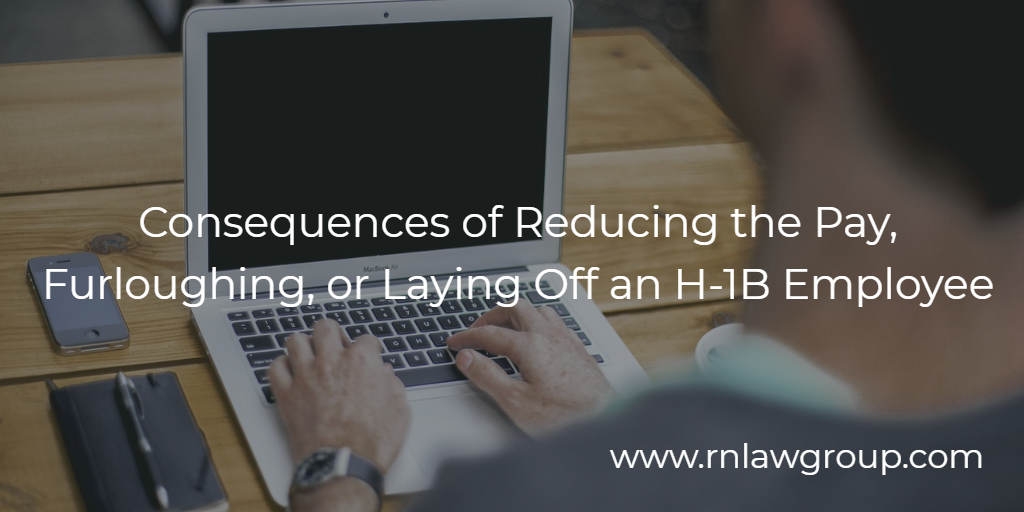
Consequences of Reducing the Pay, Furloughing, or Laying Off an H-1B Employee
Previously, the attorneys of Reddy & Neumann wrote an article concerning the process involved in hiring an H-1B non-immigrant employee to work in a remote capacity. As discussed in that article, businesses are changing now more than ever, and some of those changes may bring about immigration consequences.
As business needs change, companies may resort to having to lay off or furlough their employees. While this understandably has tremendous impact on all employees, for an employee on H-1B it will impact their immigration status as well. For an H-1B worker, their H-1B status is tied to his or her employment with a particular employer. Thus, when something occurs with their employer and they are either laid off, furloughed, or see a reduction in pay, it could directly affect their status.
This article will address the implications of such changes, specifically targeting H-1B recipients. For purposes of this article, we will be using the term furlough to mean a situation in which an employee is placed in a temporary non-productive, non-paying status due to a number of reasons but mostly due to lack of work or funds. Conversely, a lay-off is a recorded termination of employment but it is not considered so for any performance-related cause.
The Consequences of a Furlough or Reduction in Pay
The first step in filing an H-1B for a prospective employee is the filing of a Labor Condition Application (“LCA”) with the Department of Labor (“DOL”). The LCA will state information such as whether the employment will be full time or part time, job title, salary, anticipated length of employment, and location of employment. Generally speaking, these are the terms and conditions of employment for purposes of immigration, and these terms and conditions will be identified in the H-1B petition for the employee.
Employers are NOT allowed to place H-1B workers in a traditional furlough status. DOL regulations governing the LCA require that H-1B workers be paid the LCA wage rate for all nonproductive time related to employment. For full-time salaried employees, employers are required to pay the full salary, prorated for each pay period. For fulltime hourly employees, employers are required to pay the full salary for the full time hours mentioned on the H-1B petition. For part-time employees, employers must pay for at least the number of hours indicated on the H-1B petition. In essence, a traditional furlough is not possible for H-1B workers.
In lieu of a furlough, one possible option is to change a full-time employee to part-time or to reduce the salary of that employee. Note, the reduction of salaries cannot put the employee below the prevailing wage for the job type for the area of employment.
For H-1B employees, these will be considered a material change in the terms and conditions of employment. When there is a material change to an H-1B employee’s employment, the employer must amend their LCA by filing a new LCA. Based on policy from the United States Citizenship and Immigration Services (“USCIS”), the filing of a new LCA for the position will also require the employer to file an amendment petition with USCIS to notify USCIS of the changes. The new LCA and the new amendment petition must be filed before the company can make the changes to employment. It is important to note that the company can these changes while the H-1B petition is still pending with USCIS and not yet approved.
The Consequences of Laying Off an H-1B Employee
If, instead of being furloughed, an H-1B employee is outright laid off due to lack of work, lack of funds, etc., the visa holder’s status will effectively end immediately as their status is directly tied to the terms and conditions of their employer. The process to terminate an H-1B worker is not as simple as just providing them a notice of the termination, and employers are required to effectuate a “bona fide” termination. A bona fide termination requires three steps:
- The employer must notify the H-1B worker of the termination in writing (this can be done via email);
- The employer must notify USCIS of the termination in writing; and
- The employer must offer in writing to pay the H-1B worker for the reasonable costs of return transportation abroad.
Failure to execute all three steps when terminating an H-1B employee may leave the employer vulnerable to a finding by DOL that the employer owes the employee back wages which could be extended all the way until the H-1B approval expires.
Note, these requirements will not apply if the employee voluntarily quits prior to the end of the H-1B period.
While this is a very general overview of the process and differences between a H-1B employee being laid off or furloughed, there are many other potential issues that you may run into as you attempt to that you may need to address in the event that you or your H-1B employee(s) find themselves in this situation. Thus, we believe that it is important to speak to a qualified business immigration attorney to assist you in the preparation and filing of your paperwork to help reduce the chance of a denial. If you have any questions regarding this process or are in need of guidance in how to best comply with USCIS regulations, you can set up a consultation with any of our Reddy Neumann Brown PC attorneys.
By: Steven A. Brown

